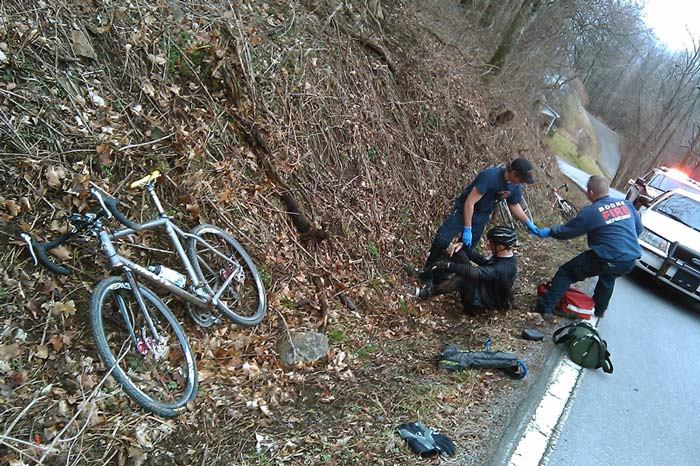
-- This sub-article is part of a larger article on road bike disc brakes called Diso-Fever. --
The photo below shows what can result from assuming that a mountain bike brake will work great on a road bike. The photo below shows the result after the rider of such a creation had to find a place to crash this expensive custom bike when the hydraulic disc brakes (supposedly adapted for road riding) failed.
Imagine beginning a long mountain descent that will last 10 minutes or so. At minute 3, you reach to pull your brakes to discover they don't work anymore. Your ultra-lightweight disc rotors heated up so fast and so hot that your hydraulic fluid boiled and turned to gas. Now your only brakes are finding a good place to crash.
The rider in this picture got off extremely lucky. He only broke 5 ribs. He wrote an entire article about the subject of road bike disc brakes, and it's fascinating. If you'd like to read the whole thing, it's here.
Realize that in the bike industry, a lot of wrong assumptions are made about products. Some bike and/or equipment designers think products made for mountain bikes will work just as well on a road bike, and visa versa. I've said it before, but it can't be said too much. Road bikes, tandems and mountain bikes are all different animals, and thus require different equipment to perform properly and safely. For instance, 2.5" knobby tires work great on mountain bikes, so why not use them for road racing? The same is true for gearing, suspension systems, etc... Why should all of the equipment be different for these bike styles, but for some reason the brakes should be the same?
It all Boils Down to This
For the most part, there is more friction and speed involved when cycling on pavement than there is when cycling on dirt, leaves, etc... Proof of this is easy to imagine for any cyclist. What happens when you lock your wheel up when cycling fast (say 30mph) off road? You slide a little right? No damage results to the tire though. Now, what about locking up the wheel while riding fast (say 45mph) on road? The tire skids, the rubber is damaged (due to greater friction between the rubber and the road).
To slow a bike that is subject to the higher speeds and the greater friction of pavement requires more energy. Energy turns into heat. As the heat builds on the rotors, it ends up in the calipers and eventually (less than 3 minutes apparently) in the hydraulic fluid. Hydraulic fluid doesn't like heat, and in this case, it boiled, and resulted in catastrophic failure.
This is why a disc brake for road use will need to be a different design with better heat dissipation than a disc brake for off-road use. For a tandem, add to the equation even greater speeds and more weight.
I don't want want anyone to think that we are anti-disc brake. The disc brake designs that are currently available work fantastic for off-road, and we have a lot of commuting customers who prefer the disc brake to save wear on their rims.
Leading edge or Bleeding edge
At Rodriguez, we refuse to use our customers for product testing purposes. We love them and want to keep them safe and alive. This is why we are not the first to become early adopters of new products just because a magazine review recommended something new. Leading edge is different than bleeding edge.
-- Read more about road bike disc brakes here: Diso-Fever. --


